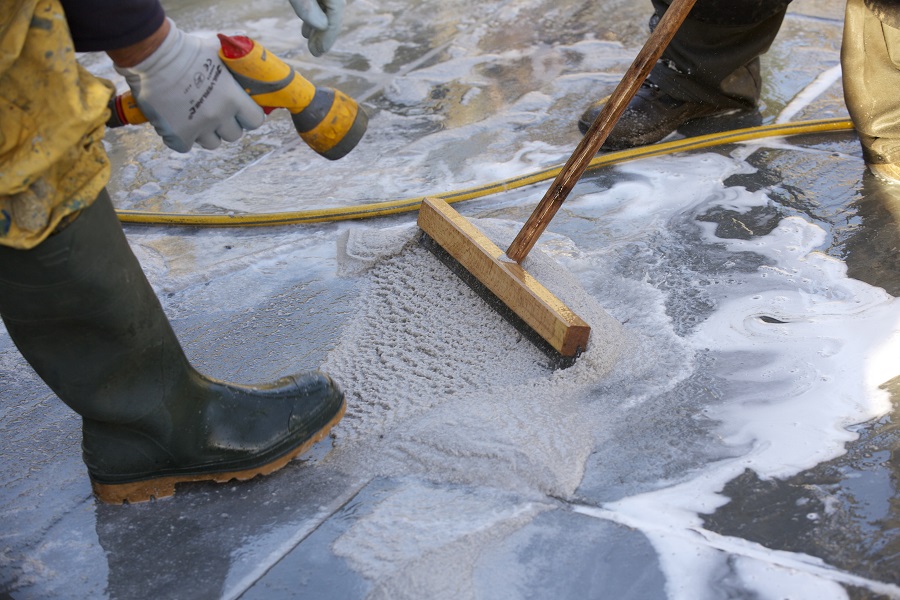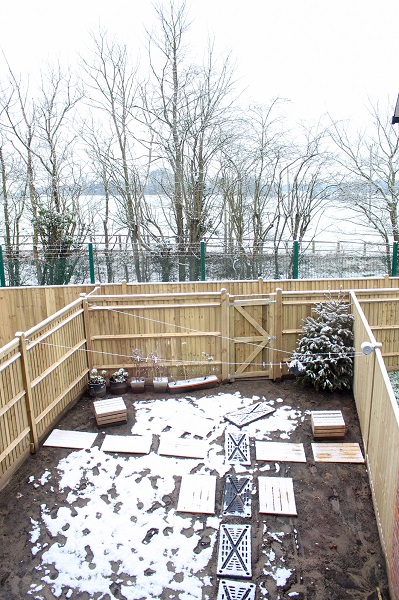Rain, frost, ice and snow are bugbears of landscaping. Find out how to make it easier to lay a patio while battling with winter weather.

Can I lay a patio in the rain?
It depends how heavy it is. Light rain and drizzle don’t present much problem, but heavy downpours are another matter. Here are some of the things that need thinking about:
- It is very important to get the paving base (MOT type 1) down as quickly as possible in wet weather, otherwise the exposed mud can quickly become waterlogged. If allowed to turn into a bog, it may take days to dry out, which is a disaster, schedule-wise.
- Sand should also be kept as dry as possible. If the bedding layer gets too wet it can settle in unpredictable ways when paving is laid on it.
- The paving needs to be kept clean, especially natural stone, which is more absorbent than porcelain. Keep a bucket and sponge close to hand to wipe any stains off the paving as quickly as possible.
If you know it’s going to rain, cover the ground with something like tarpaulin or thick plastic sheeting to prevent it becoming saturated and wait until the rain lets up before starting work. Cover materials like sand, too.
And don’t forget to cover everything over at the end of the day, whatever the weather. Winter can be unpredictable and you don’t want your work ruined by an unexpected downpour overnight.
Sealing in wet weather
Sealing, which we recommend for all sawn paving, is impossible in wet weather. It requires the natural stone to be absolutely bone dry. It’s quite possible that any stone laid at this time of year will not be properly dry until the spring.
If you are planning to lay sawn paving in winter there are three choices.
Seal the paving in the garage prior to installation. This can be a challenge if there isn’t enough space undercover for all the paving to dry out after it’s treated.
Leave sealing till a dry period in spring or later. This should also involve a thorough cleaning of the stone as well, to remove any marks that have occurred since the slabs were put down.
Have the stone sealed before it arrives on site. This is by far the easiest and most reliable method and, if carried out by an accredited operator (which we are), carries a guarantee.
Pointing in the rain
There’s one bright spot, if it’s raining. Pointing can be much harder in wet weather, but this isn’t the case if you use a brush-in compound. With these you need to keep the area saturated while sweeping the compound into the joints, and rain is perfect for the job.
Our in-depth information on pointing products will help you decide if a sweep-in grouting is right for your project.

Laying paving when it’s frosty
Laying paving slabs in cold weather is every bit as much of a challenge as wet.
Basically, if you don’t have to lay paving when it’s under 3ºC, then don’t. This avoids the possibility of frost damage. You’ll find that most pointing and cement products recommend working at no less than 3 degrees. Experienced builders won’t lay when the temperature is consistently below zero. This is because laying on frozen ground puts slabs at the mercy of the freeze/thaw action, and they’re likely to be dislodged as the ground thaws out and shrinks.
If it’s very cold rather than frozen, and you really can’t wait, then it’s important to take precautions against the effects of frost. The worst case scenario is that the mortar on which the paving is laid fails to “go off” (this means the cement doesn’t cure). To prevent this happening, you need to use a frost-proof mortar. This speeds up the curing process.
It also helps to cover the mortar over in the evenings, before the temperature drops lower, to prevent the frost from getting into it and freezing its moisture content. The cover needs to be reasonably thick and old carpet is ideal.
When it’s this cold, particular care needs to be taken when installing less porous materials, such as slate or granite paving. We often recommend a bond bridge to aid adhesion between the bedding layer and less porous paving, whatever the weather, but it’s particularly important if it’s very cold. Limestone and sandstone paving are generally more porous, so you shouldn’t have to worry about these.
Updated January 2023


/filters:quality(60)/mediadev/media/menu-pics/all-porcelain.jpg )
/filters:quality(60)/mediadev/media/menu-pics/luxury-italian.jpg )
/filters:quality(60)/mediadev/media/menu-pics/premium-italian.jpg )
/filters:quality(60)/mediadev/media/menu-pics/budget-porcelain.jpg )
/filters:quality(60)/mediadev/media/menu-pics/large-format-porcelain.jpg )
/filters:quality(60)/mediadev/media/menu-pics/wood-effect-porcelain.jpg )
/filters:quality(60)/mediadev/media/menu-pics/porcelain-planks.jpg )
/filters:quality(60)/mediadev/media/menu-pics/porcelain-setts.jpg )
/filters:quality(60)/mediadev/media/menu-pics/browse-all-paving.jpg )
/filters:quality(60)/mediadev/media/menu-pics/stone-paving.jpg )
/filters:quality(60)/mediadev/media/menu-pics/interior-tiles.jpg )
/filters:quality(60)/mediadev/media/menu-pics/stone-effect-porcelain.png )
/filters:quality(60)/mediadev/media/menu-pics/wood-effect-porcelain.png )
/filters:quality(60)/mediadev/media/menu-pics/grey-porcelain.png )
/filters:quality(60)/mediadev/media/menu-pics/beige-porcelain.png )
/filters:quality(60)/mediadev/media/menu-pics/dark-porcelain.png )
/filters:quality(60)/mediadev/media/menu-pics/light-porcelain.png )
/filters:quality(60)/mediadev/media/menu-pics/patio-grout.jpg)
/filters:quality(60)/mediadev/media/menu-pics/primers.jpg)
/filters:quality(60)/mediadev/media/menu-pics/porcelain-blades.jpg)
/filters:quality(90)/mediadev/media/menu-pics/drainage.jpg)
/filters:quality(60)/mediadev/media/menu-pics/cleaners.jpg)
/filters:quality(60)/mediadev/media/menu-pics/all-stone-paving.jpg )
/filters:quality(60)/mediadev/media/menu-pics/all-sawn-paving.jpg )
/filters:quality(60)/mediadev/media/menu-pics/all-riven-paving.jpg )
/filters:quality(60)/mediadev/media/menu-pics/indian-sandstone.jpg )
/filters:quality(60)/mediadev/media/menu-pics/limestone-paving.jpg )
/filters:quality(60)/mediadev/media/menu-pics/granite-paving.jpg )
/filters:quality(60)/mediadev/media/menu-pics/slate-paving.jpg )
/filters:quality(60)/mediadev/media/menu-pics/yorkstone-paving.jpg )
/filters:quality(60)/mediadev/media/menu-pics/stone-pavers.jpg )
/filters:quality(60)/mediadev/media/menu-pics/cobbles-setts.jpg )
/filters:quality(60)/mediadev/media/menu-pics/plank-paving.jpg )
/filters:quality(60)/mediadev/media/menu-pics/paving-circles.jpg )
/filters:quality(60)/mediadev/media/menu-pics/bespoke-paving-1.jpg )
/filters:quality(60)/mediadev/media/menu-pics/edging-stones-1.jpg )
/filters:quality(60)/mediadev/media/menu-pics/prestige-stone.jpg )
/filters:quality(60)/mediadev/media/menu-pics/grey-blue-stone.png)
/filters:quality(60)/mediadev/media/menu-pics/swatch-black-dark.jpg )
/filters:quality(60)/mediadev/media/menu-pics/swatch-buff-beige-white.jpg )
/filters:quality(60)/mediadev/media/menu-pics/sealants.jpg)
/filters:quality(60)/mediadev/media/menu-pics/all-clay-paving.jpg )
/filters:quality(60)/mediadev/media/menu-pics/alpha-clay-pavers.jpg )
/filters:quality(60)/mediadev/media/menu-pics/cottage-garden-clay-pavers.jpg )
/filters:quality(60)/mediadev/media/menu-pics/kessel-garden-clay-pavers.jpg )
/filters:quality(60)/mediadev/media/menu-pics/artisan-clay-pavers.jpg )
/filters:quality(60)/mediadev/media/menu-pics/grey-blue-clay-paver.png )
/filters:quality(60)/mediadev/media/menu-pics/red-brown-clay-pavers.png )
/filters:quality(60)/mediadev/media/menu-pics/beige-buff-clay-pavers.png )
/filters:quality(60)/mediadev/media/menu-pics/composite-decking.jpg )
/filters:quality(60)/mediadev/media/menu-pics/designboard-decking.jpg )
/filters:quality(60)/mediadev/media/menu-pics/classic-designboard.jpg )
/filters:quality(60)/mediadev/media/menu-pics/brushed-designboard.jpg )
/filters:quality(60)/mediadev/media/menu-pics/grooved-designboard.jpg )
/filters:quality(60)/mediadev/media/menu-pics/millboard-decking.jpg )
/filters:quality(60)/mediadev/media/menu-pics/grey-decking.jpg )
/filters:quality(60)/mediadev/media/menu-pics/black-charcoal-decking.jpg)
/filters:quality(60)/mediadev/media/menu-pics/brown-decking.jpg)
/filters:quality(60)/mediadev/media/menu-pics/all-build-deck.png )
/filters:quality(60)/mediadev/media/menu-pics/stone-cladding.jpg )
/filters:quality(60)/mediadev/media/menu-pics/all-garden-walling-1.jpg )
/filters:quality(60)/mediadev/media/menu-pics/facing-bricks.jpg )
/filters:quality(60)/mediadev/media/menu-pics/garden-screening.jpg )
/filters:quality(60)/mediadev/media/menu-pics/all-steps-coping.jpg )
/filters:quality(60)/mediadev/media/menu-pics/stone-garden-steps.jpg )
/filters:quality(60)/mediadev/media/menu-pics/sawn-steps.jpg )
/filters:quality(60)/mediadev/media/menu-pics/riven-steps.jpg )
/filters:quality(60)/mediadev/media/menu-pics/yorkstone-steps.jpg )
/filters:quality(60)/mediadev/media/menu-pics/bespoke-steps.jpg )
/filters:quality(60)/mediadev/media/menu-pics/porcelain-steps.jpg )
/filters:quality(60)/mediadev/media/menu-pics/off-the-shelf.jpg )
/filters:quality(60)/mediadev/media/menu-pics/stone-coping.jpg )
/filters:quality(60)/mediadev/media/menu-pics/sawn-coping.jpg )
/filters:quality(60)/mediadev/media/menu-pics/riven-coping.jpg )
/filters:quality(60)/mediadev/media/menu-pics/yorkstone-coping.jpg )
/filters:quality(60)/mediadev/media/menu-pics/bespoke-coping.jpg )
/filters:quality(60)/mediadev/media/menu-pics/stone-pier-caps.jpg )
/filters:quality(60)/mediadev/media/menu-pics/porcelain-coping.jpg )
/filters:quality(60)/mediadev/media/menu-pics/all-bespoke-services.jpg )
/filters:quality(60)/mediadev/media/menu-pics/bespoke-paving-2.jpg )
/filters:quality(60)/mediadev/media/menu-pics/bespoke-steps-1.jpg )
/filters:quality(60)/mediadev/media/menu-pics/bespoke-coping-1.jpg )
/filters:quality(60)/mediadev/media/menu-pics/edge-profiles.jpg )
/filters:quality(60)/mediadev/media/menu-pics/masonry-services.jpg )
/filters:quality(60)/mediadev/media/menu-pics/deluxe-pergolas.jpg )
/filters:quality(60)/mediadev/media/menu-pics/proteus-pergolas.jpg )



